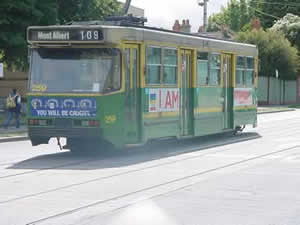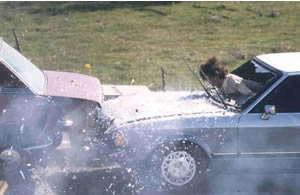Newton's First Law of
Motion |
|
| Newton's first law of motion describes how an object behaves in the absence of a net force. If the net force acting on an object is zero the object will continue to move in a straight line with no change in speed or it will remain at rest. | |
This law describes a property of all objects. Simply put, an object will not change unless acted upon by a force. This resistance to change is known as inertia. |
|
We all experience inertia and it is most obvious when travelling on a bus, train or tram. As a tram accelerates you tend to be pushed backwards. That is, your inertia will tend to keep you stationary, and you have to hold onto something to prevent yourself from colliding into the rear of the tram. If the tram stops suddenly your inertia keeps you moving forwards at the velocity you were previously travelling. This is why seat belts are important in preventing injury during high speed crashes. |
|
| Explain, in terms of inertia,
what is happening to the driver of the rear vehicle. A driver places a book on the rear window of his vehicle. He puts his seat belt on and drives off at 100 km/hr. On the freeway he collides, headon, with another vehicle. He suffered severe head injuries eventhough he was wearing a seat belt. Explain why in terms of inertia. |
|
Look at the video on the
right of an astronaut releasing sweets in the space craft. How can you tell? |
|
Continue
with Newton's second law |
|


